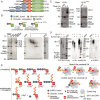SUMO enhances unfolding of SUMO-polyubiquitin-modified substrates by the Ufd1/Npl4/Cdc48 complex
- PMID: 36574706
- PMCID: PMC9910466
- DOI: 10.1073/pnas.2213703120
SUMO enhances unfolding of SUMO-polyubiquitin-modified substrates by the Ufd1/Npl4/Cdc48 complex
Abstract
The Ufd1/Npl4/Cdc48 complex is a universal protein segregase that plays key roles in eukaryotic cellular processes. Its functions orchestrating the clearance or removal of polyubiquitylated targets are established; however, prior studies suggest that the complex also targets substrates modified by the ubiquitin-like protein SUMO. Here, we show that interactions between Ufd1 and SUMO enhance unfolding of substrates modified by SUMO-polyubiquitin hybrid chains by the budding yeast Ufd1/Npl4/Cdc48 complex compared to substrates modified by polyubiquitin chains, a difference that is accentuated when the complex has a choice between these substrates. Incubating Ufd1/Npl4/Cdc48 with a substrate modified by a SUMO-polyubiquitin hybrid chain produced a series of single-particle cryo-EM structures that reveal features of interactions between Ufd1/Npl4/Cdc48 and ubiquitin prior to and during unfolding of ubiquitin. These results are consistent with cellular functions for SUMO and ubiquitin modifications and support a physical model wherein Ufd1/Npl4/Cdc48, SUMO, and ubiquitin conjugation pathways converge to promote clearance of proteins modified with SUMO and polyubiquitin.
Keywords: SUMO; quality control; segregase; stress; ubiquitin.
Conflict of interest statement
The authors declare no competing interest.
Figures







Similar articles
-
The Ufd1 cofactor determines the linkage specificity of polyubiquitin chain engagement by the AAA+ ATPase Cdc48.Mol Cell. 2023 Mar 2;83(5):759-769.e7. doi: 10.1016/j.molcel.2023.01.016. Epub 2023 Feb 2. Mol Cell. 2023. PMID: 36736315 Free PMC article.
-
Translocation of polyubiquitinated protein substrates by the hexameric Cdc48 ATPase.Mol Cell. 2022 Feb 3;82(3):570-584.e8. doi: 10.1016/j.molcel.2021.11.033. Epub 2021 Dec 23. Mol Cell. 2022. PMID: 34951965 Free PMC article.
-
Bidirectional substrate shuttling between the 26S proteasome and the Cdc48 ATPase promotes protein degradation.Mol Cell. 2024 Apr 4;84(7):1290-1303.e7. doi: 10.1016/j.molcel.2024.01.029. Epub 2024 Feb 23. Mol Cell. 2024. PMID: 38401542 Free PMC article.
-
Cdc48-Ufd1-Npl4: stuck in the middle with Ub.Curr Biol. 2002 May 14;12(10):R366-71. doi: 10.1016/s0960-9822(02)00862-x. Curr Biol. 2002. PMID: 12015140 Review.
-
Cdc48/p97 segregase: Spotlight on DNA-protein crosslinks.DNA Repair (Amst). 2024 Jul;139:103691. doi: 10.1016/j.dnarep.2024.103691. Epub 2024 May 9. DNA Repair (Amst). 2024. PMID: 38744091 Review.
Cited by
-
VCF1 is a p97/VCP cofactor promoting recognition of ubiquitylated p97-UFD1-NPL4 substrates.Nat Commun. 2024 Mar 19;15(1):2459. doi: 10.1038/s41467-024-46760-4. Nat Commun. 2024. PMID: 38503733 Free PMC article.
-
Dynamics of DNA damage-induced nuclear inclusions are regulated by SUMOylation of Btn2.Nat Commun. 2024 Apr 13;15(1):3215. doi: 10.1038/s41467-024-47615-8. Nat Commun. 2024. PMID: 38615096 Free PMC article.
-
Targeting of client proteins to the VCP/p97/Cdc48 unfolding machine.Front Mol Biosci. 2023 Feb 7;10:1142989. doi: 10.3389/fmolb.2023.1142989. eCollection 2023. Front Mol Biosci. 2023. PMID: 36825201 Free PMC article. Review.
-
Automated identification of small molecules in cryo-electron microscopy data with density- and energy-guided evaluation.bioRxiv [Preprint]. 2024 Nov 20:2024.11.20.623795. doi: 10.1101/2024.11.20.623795. bioRxiv. 2024. Update in: Structure. 2025 Jul 23:S0969-2126(25)00250-3. doi: 10.1016/j.str.2025.07.002. PMID: 39605546 Free PMC article. Updated. Preprint.
-
Mechanism of nascent chain removal by the ribosome-associated quality control complex.Nat Commun. 2025 Jul 1;16(1):5792. doi: 10.1038/s41467-025-61235-w. Nat Commun. 2025. PMID: 40595698 Free PMC article.
References
Publication types
MeSH terms
Substances
Grants and funding
LinkOut - more resources
Full Text Sources
Molecular Biology Databases
Miscellaneous

